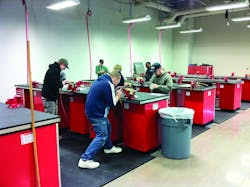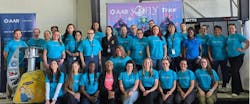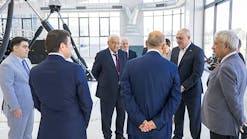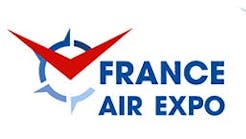You’ve read the articles and heard the chatter; the aviation industry will soon find it very challenging to hire enough qualified technicians. Aviation manufacturers and MRO facilities are both concerned about future hiring shortages. Some estimate as many as 650,000 new aviation technicians will be needed by 2030.
A recent Boeing press release states that “airlines will need an average of 23,000 new commercial jet pilots and 32,500 new technicians per year to maintain and fly an expanded world fleet expected to grow to nearly 40,000 airplanes over the next 20 years, as well as replace the coming wave of retirements.” Without enough trained talent, U.S. companies will have to turn away work.
Technician shortage
This problem, which is not unique to aviation or aerospace, has captured the attention of leaders at the highest levels of industry and government. In June, President Obama spoke on this very topic at Northern Virginia Technical College. His message was clear: the health of the U.S. economy requires the training of new workers for new technical jobs.
In the past, prior to entering technical college, students typically had a fair amount of mechanical experience, thanks either to high school tech classes or work done around the farm, home, or garage. This is not often the case today; yet those fundamental skills are all still needed, skills like reading measuring instruments, drilling accurate holes, and bolting with proper torque. Additionally, with new materials and processes, those skill sets need to be revisited, revised, and enhanced.
Another hurdle is the perception today’s potential students and their parents have of technical education: that a technical career is not a healthy choice. But today’s technicians are not knuckle-busting, wrench benders with few career options. In fact, today, one of the problems facing the aviation industry is that graduates of today’s aviation programs are swept up by other industries.
The United States is the home of innovation and in no industry is that more true than aviation. The technology in today’s aircraft requires technicians with a high level of talent and a broad base of skills not imagined before. Aircraft like Boeing’s new 787 have a tablet computer-based interface and a composite structure more advanced than most military aircraft.
New mechanics must not only be much more familiar with avionics and computer systems, but they will also need specialized composites training. They must be able to identify the correct composite repair, as making the wrong repair will render a piece irreparable. Sherry Carbary, vice president of Boeing Flight Services, recently said: "To meet the demand for capable, well-trained people, Boeing and the aviation industry need to move with the speed of technology to provide the tools, training, and work environment that tech-savvy pilots and technicians will expect from us."
The emerging work force, as well as the incumbent work force, needs high quality, industry-supported training in these fundamental skills. Partnerships between industry and educational institutions will assure that the training provided meets the needs of industry. These industry-led initiatives are a key element to successful training.
An initiative mentioned during the President’s visit to Northern Virginia Technical College is “Skills for America’s Future.” This program brings government, the private sector, labor, and community colleges together to produce 5 million community college degrees and certificates by 2020. The organization’s advisory board is composed of CEOs of companies such as Motorola Solutions, Snap-on Incorporated, and Discovery Communications.
Product certification
Snap-on Inc. has been involved in technical education for more than 50 years. Over the past five years, our efforts have increased dramatically. In 2006 Snap-on began offering curriculum-based product certifications to technical college students through partnerships with educational institutions. The initial product certifications were for automobile diagnostic scanners with the goal of producing technicians capable of using these tools to their full potential.
This program has grown and now includes certifications for many tools, pertinent to multiple disciplines. For example, current certifications include electrical measurement (multi-meter) and torque (mechanical and electrical), both of which are being offered at Part 147 aircraft maintenance schools. The curriculum is written so that it won’t add hours to a course, as instructors can break it into modules that fit into their existing course material. Students who successfully complete the course leave not only with an A&P license, but also with third-party certificates from a globally recognized brand.
Snap-on has taken a lead role in working collaboratively with educational institutions. Our third-party certifications benefit industry as much as they benefit the individual. A technician who is certified in the use of Snap-on torque instruments is much less likely to over torque a bolt, saving a company time and money.
Third-party certifications can help manufacturers and MRO facilities reduce the time and money they spend managing internal training programs, as long as the certifications are from credible providers. Currently employed technicians and their employers can take advantage of these certifications. Whether it’s a refresher course on proper torque tensioning or one that covers a topic new to the technician, these certifications add value by sharpening skills as well as teaching new techniques.
Third-party certifications benefit the technician by providing proof of transferable skills, improving their chances for employment, and paving the way for higher wages. Employers are more apt to hire someone who has demonstrated an interest in making themselves more valuable to their employer.
Perfect storm for training
In some cases, multiple organizations can work together to create a “perfect storm” for training. As a result of conversations about training requirements with representatives from the renewable energy industry, Snap-on representatives actively engaged wind-industry experts about the specific skill requirements for the next generation of workers. As a result, in 2010, the Ironworkers Union could take advantage of multiple training initiatives packaged together, supporting the wind turbine industry.
The training was held at Francis Tuttle Technology Center, a technical college in Oklahoma City. It included training in tower safety, rescue procedures, and certifications on Snap-on torque instruments. Similar discussions are taking place between representatives from the aviation industry, educational institutions, and companies that can facilitate training.
“A rising tide lifts all boats,” says Roger Tadajewski, executive director for the National Coalition of Certification Centers (NC3). “Communication between industry and educational institutions allows ‘real-time’ expertise to be shared in a training environment.” NC3 was established to assist with the development and implementation of industry recognized, portable certifications in the transportation, energy, and aviation sectors.
Wichita Area Technical College
Partnerships with technical colleges help industry keep their work force trained at the leading edge of technological advancements. An example of this type of collaboration is the program at the National Center for Aviation Training (NCAT) at Wichita Area Technical College. Thanks to partnerships with both local aviation companies and globally recognized corporations, WATC is able to offer its students state-of-the-art training in composites.
Jon Pine, WATC’s program coordinator for Aerostructures and Composites, has worked with local aviation companies in addition to globally recognized corporations. Partnerships with companies like Cessna, Spirit, Bombardier, and Hawker Beechcraft make it possible for WATC to offer its students hands-on training specific to what they will encounter in the workplace.
Hawker Beechcraft donated a Hawker 4000 all-composite fuselage and Spirit donated 787 composite engine cowlings. Snap-on provided all the tooling and tool storage for the Aerostructures Lab and the Composite Lab; the latter has Level-5 tool storage, complete with foam and asset management software, giving students an additional lesson in FOD control systems.
Another example of industry partnering with education is the National Institute of Aviation Research’s (NIAR) relationship with WATC. As NIAR builds test panels for different manufacturers, students at WATC can observe their assembly and learn why they are being built one way and not another. In order to share practices and procedures nondisclosure agreements are typically required.
While training new workers is in the interest of the entire industry, it is a difficult effort to undertake alone. So, while it is not common for competing companies to work together toward a common goal, that is what is required to meet this challenge. Of course, airlines, MROs, and manufacturers will provide training to their new hires regardless; however, they will hire those with more training and experience before those with less.
Third-party certifications supported and influenced by the aviation industry as a whole, can provide enough specialized training to allow the employer to focus on the training specific to their needs. Collaboration among competitors will be vital.
John Gamble is an education and business partnership manager with Snap-on Industrial, focusing on the aviation and aerospace sector. He can be reached at [email protected]. New certifications pertinent to aviation soon to be offered by Snap-on include Tool Control/Asset Management, FOD, Precision Hole Drilling and Hole Preparation, as well as Precision Measurement. You can learn more about current Snap-on education programs at http://education.snapon.com.






